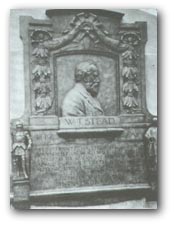At 10:30 on Saturday morning, April 4th, over 80 members and friends of the Ocean Liner Museum gathered at the Genealogical & Biographical Library on East 58th Street.
They were there for two reasons: To embark on a trek of Titanic memorials all over Manhattan and, even more important, to drink a stirrup-cup toast to our beloved trustee and colleague Walter Lord.
Walter showed up in fine fettle and was immediately besieged by throngs of ocean liner buffs anxious to shake his hand, say hello or have their copies of one of his books autographed. A photographer and report
er from the Associated Press were on hand as well and dozens upon dozens of pictures were taken.
Your Editor/President had ready a small token, designed to convey to Walter the high esteem in which the Museum's Board of Trustees and members hold him. It was a funnel bas relief--White Star, of course--and obviously of Titanic vintage. Beneath the crossed flags of Britain and the White Star Line was a small "riveted" plaque bearing the following legend:
For Walter Lord, Mr Titanic, Who Singlehandedly Raised the Vessel from the Bottom of the North Atlantic Over Four Decades Ago.
Walter took the microphone to accept the tribute and made a gracious speech of welcome to the assembly, regretting his inability to join the trek himself but delighted that so many had turned out.
The wording on the plaque said it all, really; had it not been for Walter's seminal volume, A Night to Remember, published in 1955, there is every reason to think that no Titanic musical, no film, no television recreations, no torrent of books and in sum, no worldwide Titanic mania would have consumed us as it has this past year.
As final vale, your Editor proposed three ringing cheers for Walter. They awoke the echoes, to be followed by one more. ("Give three cheers and one cheer more," goes the musical refrain praising the captain of HMS Pinafore. That same convention "three-plus-one," incidentally, governs to this day all whistled exchanges between passing vessels at sea--three long blasts followed by a brief toot that captains describe as a "kiss.")
That pleasant overture completed, with cameras, picnics, thermos's and water bottles in hand, the Titanic trekkers divided themselves between two busses waiting outside; then the convoy got under way.
The Trek Begins
 The first call was at Fifth Avenue at 91st Street where a memorial to the
British journalist, William T. Stead, adorns the wall directly across the avenue from Andrew Carnegie's mansion. (A suitable location, since Stead had lost his life en route to address a peace rally at Carnegie Hall.)
The first call was at Fifth Avenue at 91st Street where a memorial to the
British journalist, William T. Stead, adorns the wall directly across the avenue from Andrew Carnegie's mansion. (A suitable location, since Stead had lost his life en route to address a peace rally at Carnegie Hall.)
Among the member/passengers on board one of the Museum busses was Jean Seward, whose uncle had been a tablemate of Stead's in Titanic's dining saloon. She shared an intriguing anecdote. Stead, her uncle had told his family after he was rescued, was forever telling largely supernatural stories, keeping his table companions enthralled.
On the night of Sunday, April 14th, he had begged off telling one particular anecdote about an Egyptian mummy's curse because, he explained, whenever he told it, something dreadful had always happened.
But when his dinner companions would not take no for an answer, the journalist reluctantly told the tale. Just as he had predicted, "something dreadful" did happen later that night and the fabled story-teller was counted among the missing.
The next stop was at the Cathedral of St John the Divine. Along the north side of the nave, down in the lower right-hand corner of a tall, stained-glass window is a small but vivid representation of an ocean liner in obvious peril, her funnels, alas, bright red. That portion of the window had been dedicated by friends in memory of Colonel and Mrs Astor. Just below the window, affixed to the wall on a recently installed brass plaque, were inscribed the names of all those who had perished in the crash of TWA Flight 800, a tragic contemporary disaster on an horrific par with the White Star liner's loss.
A very short distance away from St John's--at Broadway and 106th Street--is the memorial to Mr and Mrs Isidor Straus, a pensive, serene bronze female figure reclining atop a marble fountain.

